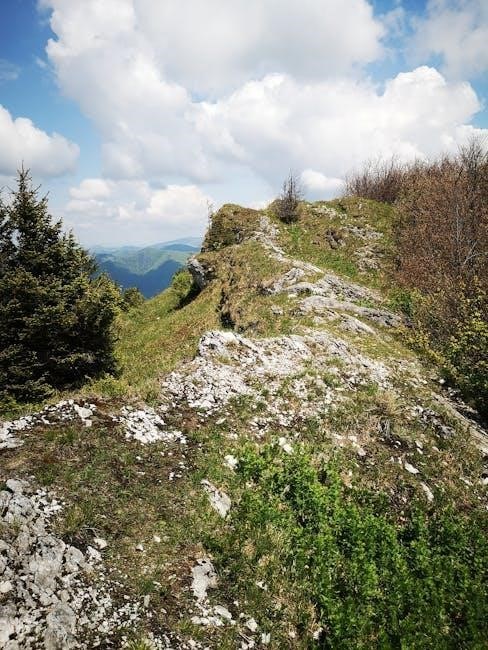Rock tumbling transforms rough stones into polished treasures, revealing their hidden beauty․ It’s a creative, rewarding hobby that turns ordinary rocks into sparkling, smooth gemstones․
What is Rock Tumbling?
Rock tumbling is a fascinating process that transforms rough rocks into smooth, polished gemstones․ It involves using a machine that tumbles rocks with grit and water through several stages: coarse, medium, fine grit, and polishing․ The process is gradual, starting with rough grinding and ending with a high-shine finish․ Plastic pellets and ceramic cylinders assist in the tumbling, helping to protect and polish the stones․ This hobby allows enthusiasts to uncover the hidden beauty of ordinary rocks, turning them into sparkling treasures․ By following specific instructions and maintaining records, rock tumbling becomes a rewarding and creative activity, perfect for those interested in geology and crafting․
Why Rock Tumbling is a Great Hobby
Rock tumbling is an excellent hobby for those passionate about geology and crafting․ It offers a unique blend of creativity and science, allowing enthusiasts to transform rough stones into polished gems․ The process is both meditative and rewarding, providing a sense of accomplishment as each rock evolves․ It’s also a great way to connect with nature and explore the beauty of minerals․ Additionally, rock tumbling encourages experimentation, as different grits and techniques can yield varied results․ Joining a rock club can further enhance the experience, offering tips and support from fellow hobbyists․ Whether for personal enjoyment or to create gifts, rock tumbling is a fulfilling and engaging pastime that combines art and earth․
Preparing Your Rocks for Tumbling
Proper preparation ensures smooth tumbling․ Clean and sort rocks by size and hardness to avoid damage․ This step sets the stage for a successful tumbling process․
How to Select the Right Rocks for Tumbling
Selecting the right rocks for tumbling is crucial for success․ Look for rocks with hard, durable surfaces, as soft or fragile stones may break during the process․ Avoid porous or crumbling materials․ Consider the size and shape of the rocks; smaller, uniform pieces tumble more evenly․ Agate, jasper, and quartz are popular choices due to their hardness․ Ensure the rocks are free from cracks or weak spots․ Experimenting with different types can lead to unique results, but always start with harder materials for better outcomes․
Remember, the quality of the final product heavily depends on the initial selection of the rocks․ Choose wisely for polished perfection․
Cleaning and Preparing Rocks Before Tumbling
Cleaning and preparing rocks is essential before tumbling․ Start by rinsing the rocks under water to remove dirt and debris․ Use a stiff brush to scrub away stubborn particles․ For tougher grime, soak the rocks in water or a mild detergent solution․ Never use harsh chemicals, as they can damage the stones․ Dry the rocks thoroughly before tumbling to prevent moisture interference․ Remove any weak or broken edges to ensure smooth processing․ Proper preparation ensures the tumbling process is effective and prevents damage to both the rocks and the tumbler․ A clean, dry start leads to better final results․ Always inspect each rock for any remaining imperfections before proceeding․

Equipment and Supplies Needed
A rock tumbler machine, plastic pellets, and ceramic cylinders are essential; Additional supplies include grit kits, water, and a measuring cup for precise mixing․ Proper equipment ensures smooth tumbling․
Understanding Rock Tumbler Machines
Rock tumbler machines are the cornerstone of the tumbling process, designed to transform rough stones into polished gems․ These machines operate by rotating a barrel filled with rocks, water, and abrasive grit․ The continuous motion smooths and polishes the stones over several days․ There are two main types: rotary and vibratory tumblers․ Rotary tumblers are more common for hobbyists, using a rotating drum to tumble rocks, while vibratory tumblers are typically used for finer polishing․ Proper setup and maintenance ensure optimal performance, making them indispensable for achieving professional-grade results․ Regular monitoring and timely grit changes are crucial for successful tumbling․
Using Plastic Pellets in Rock Tumbling
Plastic pellets play a crucial role in rock tumbling by acting as a buffer between stones, preventing them from scratching or breaking during the tumbling process․ These pellets are particularly useful when tumbling delicate or fragile rocks․ They also help to maintain even movement within the tumbler barrel, ensuring all stones are evenly polished․ Typically, a ratio of 1-2 tablespoons of pellets per pound of rocks is recommended․ They are reusable and can be cleaned and dried for future use․ Adding pellets reduces noise and wear on the machine, while also improving the overall efficiency of the tumbling process․ Proper use of plastic pellets enhances the quality of the final polished stones․
Role of Ceramic Cylinders in the Tumbling Process
Ceramic cylinders are essential in rock tumbling as they assist in evenly distributing the abrasive grit and water mixture during the polishing stages․ These cylinders are designed to gently abrade the rocks, helping to remove imperfections and smooth out surfaces․ They are typically used in the finer grit stages, where precision is key to achieving a high luster․ Ceramic cylinders also help to prevent the rocks from colliding too harshly, reducing the risk of damage․ By providing consistent contact, they ensure uniform polishing across all stones․ They are reusable and can be cleaned for multiple uses․ Properly incorporating ceramic cylinders enhances the efficiency and effectiveness of the tumbling process, leading to beautifully polished gemstones․

The Rock Tumbling Process
The rock tumbling process involves four stages: coarse grit, medium grit, fine grit, and polishing․ Each stage progressively smooths and polishes the rocks․
The coarse grit stage is the first step in rock tumbling, designed to smooth rough edges and surfaces․ Fill the tumbler barrel about two-thirds with rocks, ensuring a mix of sizes․ Add water and coarse grit, typically 60-80 mesh, following the manufacturer’s guidelines․ Seal the barrel and run the tumbler for two to three days․ After this initial period, inspect the rocks to assess progress․ The coarse grit stage lays the foundation by removing major imperfections․ Properly monitoring the process ensures the rocks are ready for the next stage․ This step is crucial for achieving a smooth finish in subsequent stages․ The medium grit stage refines the rocks further, following the coarse grit stage․ Replace the coarse grit with medium grit, typically 120-220 mesh, and add fresh water․ Ensure the tumbler is clean to prevent contamination․ Run the tumbler for 7-10 days to smooth out remaining scratches․ For harder rocks, extend the tumbling time if needed․ After this stage, the rocks should feel noticeably smoother, with fewer visible imperfections․ Properly cleaning the rocks and the tumbler between stages is essential for optimal results․ This step transitions the rocks from rough to polished, preparing them for finer grits․ Consistency and patience are key to achieving the desired smoothness․ The fine grit stage further polishes the rocks, enhancing their smoothness and luster․ Replace the medium grit with fine grit, typically 400-600 mesh, and add clean water․ Ensure the tumbler is free of residue to maintain effectiveness․ Run the tumbler for 7-10 days, allowing the finer abrasive to remove minor scratches and imperfections․ The rocks should now feel silky smooth and begin to develop a subtle shine․ Inspect them periodically to avoid over-polishing, which can erode details․ Properly cleaning the rocks and tumbler between stages is crucial for achieving the best results․ This stage is vital for preparing the rocks for the final polishing stage, ensuring they are ready to reveal their full beauty․ Patience and attention to detail are essential during this phase․ The polishing stage is the final step in transforming rough rocks into dazzling, high-gloss gemstones․ Replace the fine grit with a polishing compound, such as cerium oxide or aluminum oxide, and add water as instructed․ Ensure the tumbler is clean to prevent contamination․ Run the tumbler for 7-14 days, allowing the polish to work its magic․ During this stage, the rocks will develop a brilliant, mirror-like finish․ After polishing, rinse the rocks thoroughly with water to remove any residue․ Inspect each stone to ensure they meet your desired level of shine․ This stage is the culmination of your patience and effort, revealing the full beauty of your tumbled rocks․ Proper polishing brings out the vibrant colors and intricate patterns, making the stones ready for display or jewelry․ Patience is key in rock tumbling, as each stage requires time to achieve smooth, polished results․ Always clean the tumbler thoroughly between stages to prevent contamination․ Keeping detailed records is crucial for achieving consistent results in rock tumbling․ Documenting the type and quantity of rocks, grit used, and the duration of each stage helps track progress and replicate successful outcomes․ By noting observations after each step, you can refine your technique and avoid repeating mistakes․ Record-keeping also allows you to experiment with different grit sequences and polishing compounds, ensuring optimal results for various rock types․ Over time, these records become a valuable resource for improving your skills and sharing knowledge with others․ Consistent documentation enhances the overall tumbling experience and contributes to mastering the craft․ Joining a rock club can significantly enhance your rock tumbling journey․ Clubs provide access to experienced members who share tips, techniques, and insights, helping you refine your skills․ Participating in group projects and workshops allows you to learn from others and gain hands-on experience․ Additionally, clubs often host events and competitions, which can inspire creativity and motivation․ Collaborating with fellow enthusiasts fosters a sense of community and camaraderie, making the hobby more enjoyable․ Many clubs also offer resources, such as equipment and material discounts, further supporting your tumbling endeavors․ By connecting with like-minded individuals, you can achieve better results and discover new opportunities in the world of rock tumbling․Step 1: Coarse Grit Stage
Step 2: Medium Grit Stage
Step 3: Fine Grit Stage
Step 4: Polishing Stage

Tips for Success

Importance of Record-Keeping in Rock Tumbling
Joining a Rock Club for Better Results





